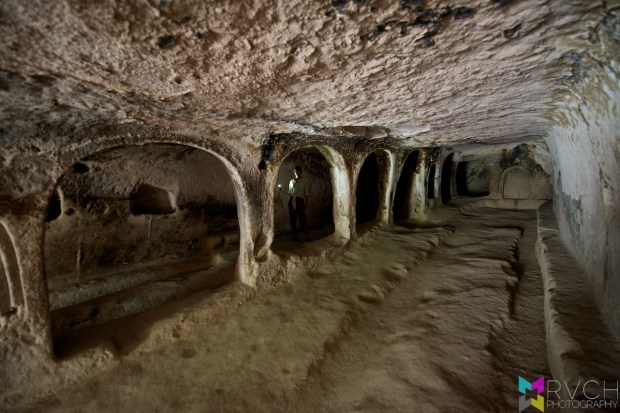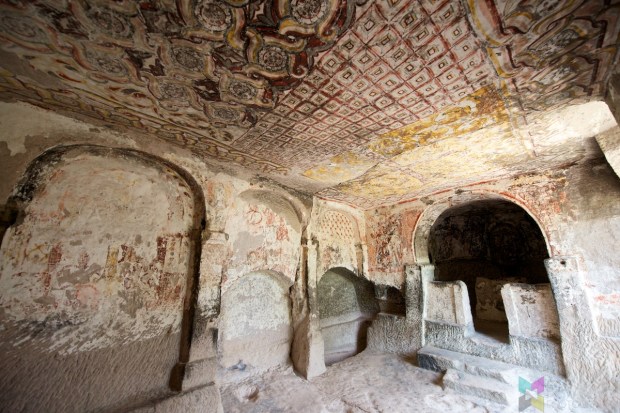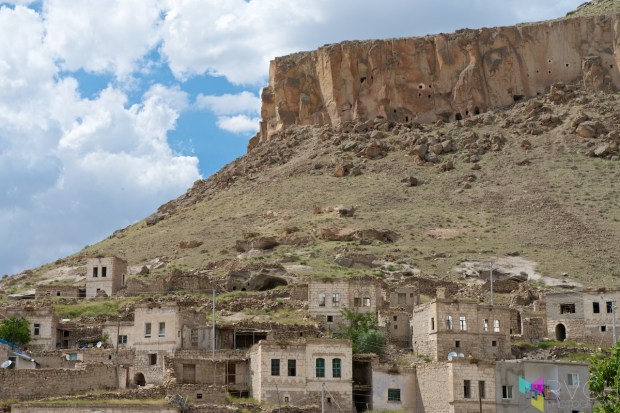It was hard to say good-bye to our luxury suite. But, it was a little easier knowing that we were going to search for a ‘fairy chimney’ hotel for the night, instead. They aren’t cheap (for Turkey), but when else is opportunity to stay in a (luxury) cave going happen? Not often I think. So, we ponied up even more cash (€90/night) for a luxury cave suite. I thought the room we just checked out of was amazing, but this new place is more amazing than any hotel I’ve ever stayed in. Admittedly, since I almost always stay in the most budget of hotels, it’s not a hard feat to top. At first I thought that the price was pure extravagance, but then I thought about what $130 a night will get you in Australia, probably not much since the business hotels I’ve stayed in Newcastle and Darwin are twice that price a night!
Anyway, enough with the gushing about the hotel. We would have stayed and just enjoyed the room, but it wasn’t ready for us until this afternoon, so we went to explore a little more of the Cappadocia area.
There are a lot of tours run in the area, and to make it simpler for us tourist folk, they have been colour coded. Today we were off to do a ‘Blue Tour’, which visits some of the nearby monasteries in Soganli. Since we had our own vehicle, we did a DIY version of the tour.
Soganli is advertised as Star Wars location, and I would have believed it, as the whole Cappadocia area has a very sci-fi feel to it. Sadly, it’s just lies, none of Star Wars was filmed in Turkey. Instead, we get to see the remains of several ancient monasteries and churches, as well as some beautiful valleys.

 But, before we started on the tour, we had a quick stop just on the outskirts of Göreme to photograph a stunning set of Fairy Chimneys – and let’s be honest, they’re pretty amazing!
But, before we started on the tour, we had a quick stop just on the outskirts of Göreme to photograph a stunning set of Fairy Chimneys – and let’s be honest, they’re pretty amazing!
The first proper stop was at the Keslik Monastery, which is a large complex of buildings all built into the rock about an hour’s drive from Göreme. After we paid a few lira to the caretaker, we were free to roam around the area as we saw fit. He pointed out a few highlights, so we started with them.



 The first church didn’t look like much from the outside, but crouching through the door carved into the sandstone, we found ourselves inside a large room, with a beautifully carved domed ceiling all supported by carved columns. The walls and roof had been covered in religious frescos, however there had been a great deal of vandalism, first by raiding Arabs who scratched the eyes and faces off, and later by tourists keen to leave their name scratched into the walls. There were a few that escaped vandalism due to them being higher than someone can easily reach.
The first church didn’t look like much from the outside, but crouching through the door carved into the sandstone, we found ourselves inside a large room, with a beautifully carved domed ceiling all supported by carved columns. The walls and roof had been covered in religious frescos, however there had been a great deal of vandalism, first by raiding Arabs who scratched the eyes and faces off, and later by tourists keen to leave their name scratched into the walls. There were a few that escaped vandalism due to them being higher than someone can easily reach.

 There were non-church buildings, too, including a large dining hall and many smaller dwellings.
There were non-church buildings, too, including a large dining hall and many smaller dwellings.


 But, the churches were the standout, especially the second one with the multi-story main hall and the intricate pulpit.
But, the churches were the standout, especially the second one with the multi-story main hall and the intricate pulpit.


 It was a (very) quick stop at the ruins of Sobesos, where apart from some foundations (complete with remains of the underfloor heating), a few toppled columns and some large and well preserved mosaics in what used to be a church, there wasn’t much else to see. Still, it was a good enough excuse to get out of the car for a couple of minutes, even more so as it was free.
It was a (very) quick stop at the ruins of Sobesos, where apart from some foundations (complete with remains of the underfloor heating), a few toppled columns and some large and well preserved mosaics in what used to be a church, there wasn’t much else to see. Still, it was a good enough excuse to get out of the car for a couple of minutes, even more so as it was free.



 The drive to Soganli continued, passing through several beautiful old villages on the way. Occasionally we’d see what looked like dwellings carved into the cliffs on the side of the roads. It wasn’t as spectacular driving as some of the places along the Mediterranean, but it was still beautiful. The other thing that caught our attention was what looked like garages that were built into the sandstone. I couldn’t contain my curiosity, so I stopped for a closer look. I could smell the onions before I could see them through some gaps in the large steel doors. The caves seemed to be used for storage (of onions, and I’m not sure what else). It also explained all the small chimney/vents we could see above the ‘garages’.
The drive to Soganli continued, passing through several beautiful old villages on the way. Occasionally we’d see what looked like dwellings carved into the cliffs on the side of the roads. It wasn’t as spectacular driving as some of the places along the Mediterranean, but it was still beautiful. The other thing that caught our attention was what looked like garages that were built into the sandstone. I couldn’t contain my curiosity, so I stopped for a closer look. I could smell the onions before I could see them through some gaps in the large steel doors. The caves seemed to be used for storage (of onions, and I’m not sure what else). It also explained all the small chimney/vents we could see above the ‘garages’.

 We hadn’t timed lunch very well, as by the time we were hungry, we’d left the small towns far behind. Instead, we ended up at a small restaurant on the side of the main road. It was a large outdoor restaurant, but it was empty. It took a while, but eventually a smiley old Turkish lady walked out. There wasn’t a menu, and she spoke only a few select English words, so we were relieved when a delicious plate of food came out. I don’t know what it was, but it hit all the right taste buds! The glass of ayran however was way too extreme for me, and it was a bit of a struggle to finish. I knew it was a mistake not confirming the price beforehand, as it was a bit of shock when the fill finally came out for nearly 40TL ($20). But, it was delicious, and we had a good laugh with the old lady (who fell in love with Risa’s fake RayBans!).
We hadn’t timed lunch very well, as by the time we were hungry, we’d left the small towns far behind. Instead, we ended up at a small restaurant on the side of the main road. It was a large outdoor restaurant, but it was empty. It took a while, but eventually a smiley old Turkish lady walked out. There wasn’t a menu, and she spoke only a few select English words, so we were relieved when a delicious plate of food came out. I don’t know what it was, but it hit all the right taste buds! The glass of ayran however was way too extreme for me, and it was a bit of a struggle to finish. I knew it was a mistake not confirming the price beforehand, as it was a bit of shock when the fill finally came out for nearly 40TL ($20). But, it was delicious, and we had a good laugh with the old lady (who fell in love with Risa’s fake RayBans!).
 While we waited in nervous anticipation for lunch to come out, we watched the families roll by on their tractors, each and everyone bringing a smile to my face. I was too slow with the camera to shoot the group of ladies who looked like sheik gangsters.
While we waited in nervous anticipation for lunch to come out, we watched the families roll by on their tractors, each and everyone bringing a smile to my face. I was too slow with the camera to shoot the group of ladies who looked like sheik gangsters.


 It wasn’t much further until we were heading up a narrow valley, flanked either side by cliffs, towards Soganli. There was a small entry fee, which conveniently our Cappadocia Pass covered. There were hundreds of caves carved out of the conical sections of rock, and some of them were sign posted. We stopped at Karabas (Black Hat), and much like the earlier churches at Sobesos, it wasn’t until we were inside did we understand the grandeur of this place. It wasn’t a large church, but it seemed that every surface had been covered in frescos depicting religious scenes. Sadly, as with Sobesos, there was significant vandalism, both by Arab raiders and by tourists – some of which were from the 19th century!
It wasn’t much further until we were heading up a narrow valley, flanked either side by cliffs, towards Soganli. There was a small entry fee, which conveniently our Cappadocia Pass covered. There were hundreds of caves carved out of the conical sections of rock, and some of them were sign posted. We stopped at Karabas (Black Hat), and much like the earlier churches at Sobesos, it wasn’t until we were inside did we understand the grandeur of this place. It wasn’t a large church, but it seemed that every surface had been covered in frescos depicting religious scenes. Sadly, as with Sobesos, there was significant vandalism, both by Arab raiders and by tourists – some of which were from the 19th century!
 We drove to the end of one of the valleys, parked the car and went for a walk into the hills. We passed a small cave house that could have been a movie set for The Hobbit. It looked like someone still lived there, too!
We drove to the end of one of the valleys, parked the car and went for a walk into the hills. We passed a small cave house that could have been a movie set for The Hobbit. It looked like someone still lived there, too!


 The people who used to live out here must have been deeply pious, as I don’t think I’ve ever seen such a dense concentration of churches before. There were large and elaborate ones, and some truly tiny ones.
The people who used to live out here must have been deeply pious, as I don’t think I’ve ever seen such a dense concentration of churches before. There were large and elaborate ones, and some truly tiny ones.




 The whole area was beautiful, and if we had the time it would have been easy to have spent a few hours wondering around looking at all the valleys had to offer, but, we had our very own luxury cave to return to.
The whole area was beautiful, and if we had the time it would have been easy to have spent a few hours wondering around looking at all the valleys had to offer, but, we had our very own luxury cave to return to.
 … but not before a quick stop in Urgup.
… but not before a quick stop in Urgup.


 We spent a little too much on lunch, so to make up for it, dinner was a cheap pide takeaway eaten on the balcony of our cave house, while we watched the sun set. Pure bliss.
We spent a little too much on lunch, so to make up for it, dinner was a cheap pide takeaway eaten on the balcony of our cave house, while we watched the sun set. Pure bliss.

 We finally learnt the story behind the ‘fairy chimneys’, too. They were originally built for pigeons to live in, not for people. Farmers would then collect the pigeon droppings to use for fertilizing their crops, thus forming a mutually beneficial partnership. Keeping true to the roots, our cave room was decorated inside with various pigeon murals, including foxes and beautiful vines. The holes in the walls aren’t for storage, either – they are where the pigeons used to roost. The only complaint was the round bed, which looks really cool, but ends up being much smaller.
We finally learnt the story behind the ‘fairy chimneys’, too. They were originally built for pigeons to live in, not for people. Farmers would then collect the pigeon droppings to use for fertilizing their crops, thus forming a mutually beneficial partnership. Keeping true to the roots, our cave room was decorated inside with various pigeon murals, including foxes and beautiful vines. The holes in the walls aren’t for storage, either – they are where the pigeons used to roost. The only complaint was the round bed, which looks really cool, but ends up being much smaller.












































Leave a Reply